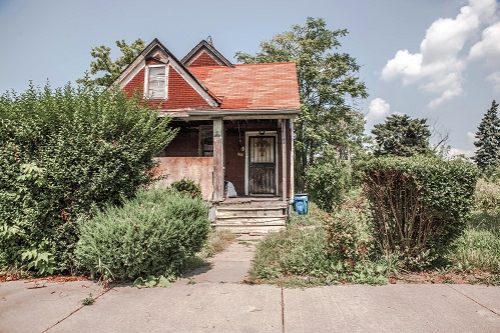Recommended home insurance coverage
To ensure you have the coverage you need, check the table below to compare standard coverage with the better option available as an upgrade.
You may also want to consider buying an HO-5 policy over an HO-3 policy if you need more coverage than a standard policy offers. HO-5 policies provide extended personal property coverage including replacement cost.
| Coverage type | Standard home policy | Better coverage |
|---|---|---|
| Dwelling | Replacement cost coverage | Extended or guaranteed replacement cost |
| Personal property | 50%-70% of dwelling coverage paid at actual cash value | Replacement cost coverage or a scheduled endorsement for specific items |
| Liability | $100,000 | $300,000-$500,000, or add an umbrella for $1M and beyond |
| Other structures | 10% of your dwelling | Increase according to what structures you have on your property |
| Flood | Not covered | Buy a separate flood policy |
| Earthquake | Not covered | Buy a separate policy or add an endorsement |
How to estimate how much homeowners insurance you need
To estimate how much insurance you need, start by calculating the replacement cost of your home. This is how much it would cost to rebuild your home from scratch using labor and materials in your area at today’s market prices.
Your insurance company has a calculator that will create an accurate assessment of your home to determine the right replacement cost value. An independent home appraiser can also accomplish this, and it’s a good idea to have it done independently if you’re getting different numbers from different insurers.
“Valuations are not an exact since so look at adding an extended replacement cost endorsement to the policy in case building values change during the policy period,” Jones says.
Because many of the other coverages on your policy are based on the dwelling coverage, it’s vital to get this right to ensure you are properly covered.
Every standard coverage limit can always be increased if your situation requires more, either through increased limits, endorsements, umbrella insurance or other separate policies. It’s important to go over each carefully with an insurance expert.
What to look for in homeowners insurance
Every home insurance policy is made up of different sections that protect different aspects of your home and property, and you must decide how much coverage you should have.
Choosing the right dwelling coverage
The dwelling coverage portion is section A of your home policy. This covers the actual structure of your home and is the most important part of your home insurance. You need enough dwelling coverage to rebuild your entire home and any attached structures.
“Most people think they have an idea of what their home is worth, but they need to understand the difference between what it may sell for and what it would cost to rebuild,” says Jake Jones, owner and agent at North Wyoming Insurance in Buffalo, WY. “Your insurance agent can go through the construction details of your home with you and run a reconstruction cost estimate to determine the appropriate value to insure your home for.”
This is called replacement cost, which is what it would cost to rebuild your home from scratch at today’s prices. It’s possible to do a simplified calculation using the square footage multiplied by the average cost per square foot of new construction in your local area, but that’s not recommended as it’s not accurate. Many insurance companies have an online calculator for dwelling coverage or your agent can assist you so you don’t make any errors.
Dwelling limits are something you should review each year and any time you make major changes to your home, as the cost to rebuild it changes when you renovate. For extra protection, consider adding extended replacement cost coverage or even guaranteed replacement cost coverage if it’s available.
Other structures
Section B is for other structures and covers detached structures like sheds, garages, fences, gazebos and swimming pools.
Other structures coverage is calculated as a percentage of your dwelling coverage, typically 10%. If you have expensive structures on your property that exceed that 10%, you should increase your other structures coverage limit. For instance, let’s say you’ve built a high-end outdoor kitchen complete with a pizza oven and firepit. If this were taken down in a storm, the cost to replace everything may require a higher dollar amount than 10% of your dwelling limits. You can adjust this with your insurer.
Choosing the right personal property coverage
Coverage C on your policy is for personal property, and it protects all the contents of your house. It even provides coverage if you bring your belongings on vacation. Again, the base coverage is calculated using a percentage of the dwelling coverage, generally 50% to 70% depending on your policy. However, what’s included may not be enough.
You should take inventory of all your belongings, from furniture and appliances to jewelry and musical equipment and decide what it would cost to replace all of them in case of a fire, theft or other disasters. This will help you to determine whether the included amount is enough.
Personal property is covered at actual cash value on a standard home insurance policy, meaning the policy will only pay the depreciated value of the items. You can upgrade to personal property replacement cost coverage as an endorsement, and it’s highly recommended that you do so.
A scheduled personal property endorsement or floater for high-value items might be a good idea to cover specific pieces of jewelry or art.
Additional living expenses/Loss of use
Additional living expenses (ALE) is section D and provides money for your family if you need to live elsewhere because your home is damaged by a covered peril. This coverage pays for things like a hotel stay, food, and even transportation and pet boarding fees. It’s typically calculated as about 20% of your dwelling. This amount can be increased for your peace of mind as well.
Personal liability coverage
Listed as coverage section E, personal liability is an important part of your home insurance. It protects you from lawsuits and situations where you’re financially responsible for damage to other people’s property or bodily injury. It covers accidents on your property like people falling down your stairs and dog bites. It covers damage to your neighbor’s roof if your tree falls on it. It also covers you if you’re traveling abroad and cause damage to property.
Standard home insurance comes with $100,000 in liability, but experts recommend increasing that to at least $300,000, more if you have a lot of assets to protect. You may also want to consider an umbrella insurance policy if you need more coverage than home insurance can provide.
“Liability premiums are relatively cheap for the amount of coverage you can purchase, so it’s recommended to buy as much as reasonably possible and affordable. Make sure it’s enough to cover a person’s current and even future assets,” Jones says.
Medical payments to others is a type of liability and is Coverage F on your policy. This covers medical bills for someone injured on your property regardless of fault. If your child’s friend gets a cut that needs stitches while at your house, this coverage kicks in for their urgent care visit. It usually caps out at around $5,000.
Do you need additional insurance coverage?
There are certain scenarios that require additional insurance; your standard homeowners policy doesn’t cover everything.
Floods and earthquakes are not covered, for instance, and they can cause devastating damage to your home. If you live in an area prone to flooding or heavy rainfall, consider a flood policy. If you live in an area with seismic activity, consider an earthquake policy.
“Even homes in areas not prone to flood or earthquakes should consider these coverages since they are excluded from a typical homeowners policy,” Jones says. “For people that live in areas not prone to these disasters coverage can be purchased for fairly cheap and protect against things they might not even think of as a flood or earthquake.”
Other things to consider are endorsements that increase coverage you already have or cover things otherwise excluded, like water backup coverage. Some people add cyber security or identity theft coverage. Ask your agent about the additional coverage available that might be right for you.





